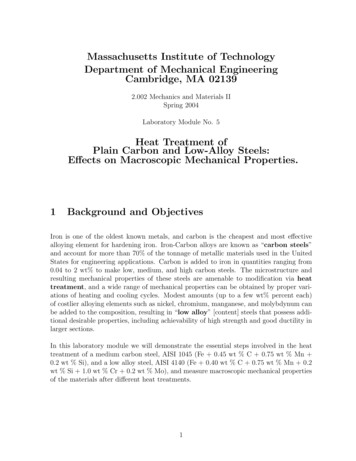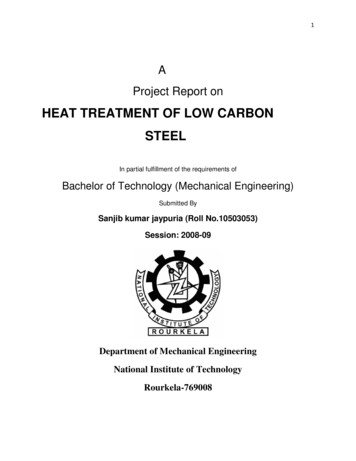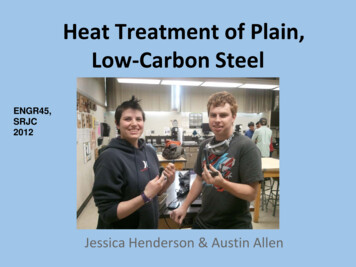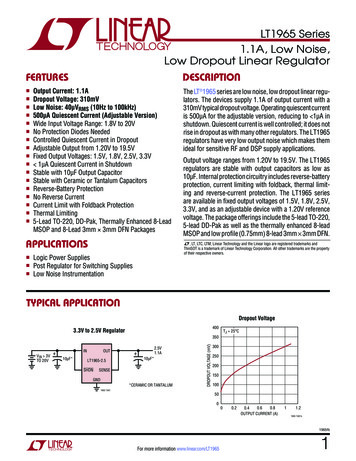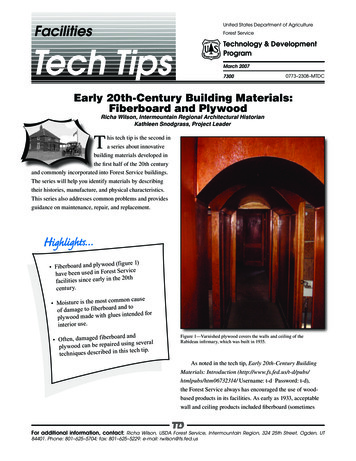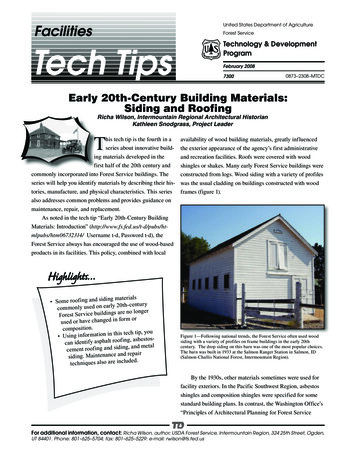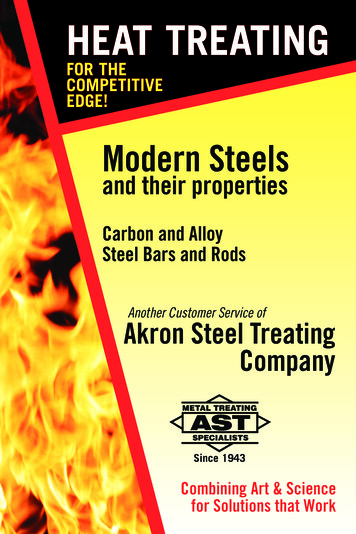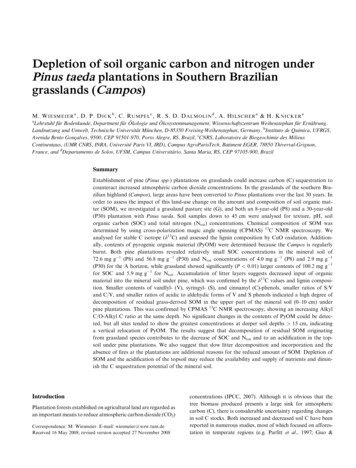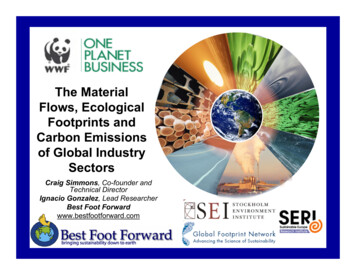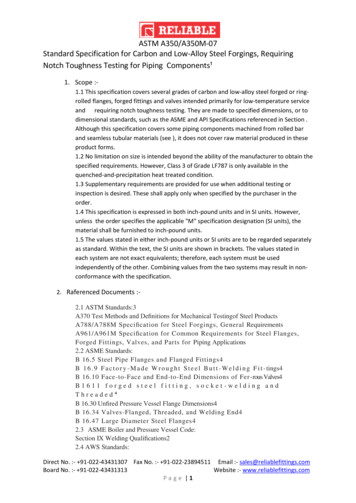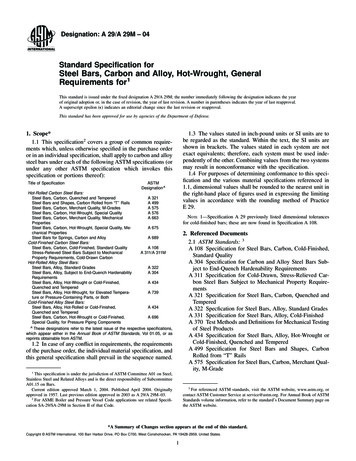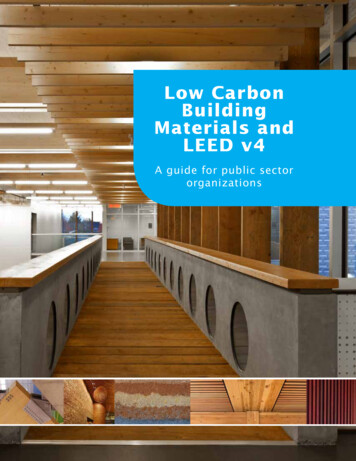
Transcription
Low CarbonBuildingMaterials andLEED v4A guide for public sectororganizations
Cover image: Bridge at L’École Mer et Montagne, Campbell River, B.C.Photo: Derek Lepper 2017 BC Ministry of the Environment andClimate Change Strategy
Table of ContentsLow Carbon Building Materials and LEED v4: A guide for public sector organizationsIntroduction. 5Why Embodied Carbon? . 6Using Wood and PLCin Building Design andConstruction. 6Leadership in Energy andEnvironmental Design. 11Low Carbon Building Materials andLEED v4. 13Conclusion. 17Case Studies. 20Ronald McDonald House BC Yukon, Vancouver B.C.(Photo courtesy of: Equilibrium, Photographer: EmaPeter).
WOOD INNOVATION & DESIGN CENTRE University of NorthernBritish Columbia, Prince George, B.C. (Photo: Ema Peter)
Low Carbon Building Materials and LEED v4A GUIDE FOR PUBLIC SECTOR ORGANIZATIONSLow Carbon Building Materials and LEED v4:A guide for public sector organizations.has also highlighted low carbon buildingmaterials as one of the following four keycomponents of a Zero Carbon Building:RONALD MCDONALD HOUSE BC Women’s andChildren’s Hospital Vancouver, B.C. (Photo: Ema Peter)IntroductionThe Government of British Columbia (B.C.)is committed to demonstrating leadership inclimate action and clean economic growth.This includes promoting the use of lowcarbon materials in public sector buildingprojects, as well as an increased focus onthe embodied carbon of building materialsan area historically neglected by the buildingindustry.B.C. government policy currently requiresthat all newly constructed public sectorbuildings achieve Leadership in Energyand Environmental Design (LEED ) Goldor equivalent certification1. The most recentiteration of LEED, known as LEED v42, hasseen the most rigorous update of this greenbuilding rating system. LEED v4 rewardsthe use of low carbon building materials inways previous versions did not. The CanadaGreen Building Council (CaGBC 3)through the Zero Carbon Buildings Initiative4123456 Zero Carbon Balance Efficiency Renewable Energy Low Carbon MaterialsThis move to promote the use of low carbonbuilding materials is likely to receiveincreasing amounts of attention across theCanadian building industry.B.C. has already established itself as a leaderin the use of low carbon building materialswith the Wood First Initiative5 and the earlyacceptance of Portland-limestone cement(PLC). The B.C. forest industry accountsfor approximately 6%6 of B.C. jobs and PLCis manufactured in Metro Vancouver underthe Canadian brand name Contempra . Byencouraging the use of low carbon buildingmaterials in public sector buildings,building owners, project managers andcapital planners can contribute to B.C.industries, the communities they supportand a low carbon future.This guide will provide a high level overview oflow carbon building materials, with a particularfocus on wood and PLC, and will describehow to incorporate low carbon buildingmaterials into LEED v4 projects pursued bypublic sector organizations (PSOs).Reducing Greenhouse Gas (n.d.). URL: http://www2.gov.bc.ca/gov/content?id DF281B134D19469E98679E9A91CF043ELEED v4, the Newest Version of LEED Green Building Program Launches at USGBC’s Annual Greenbuild Conference (2013). URL: annual-greenbuild-confeCanada Green Building Council (2017). URL: www.cagbc.orgZero Carbon Building Initiative (2016). URL: https://www.cagbc.org/zerocarbonWood First Initiative (n.d.). URL: �s Forest Industry and the B.C. Economy in 2016 (2017). URL: Report-FINAL-Sept-2017.pdfThis guide willprovide a high leveloverview of lowcarbon buildingmaterials, with aparticular focus onwood and PLC, andwill describe howto incorporate lowcarbon buildingmaterials into LEEDv4 projects.5
6A GUIDE FOR PUBLIC SECTOR ORGANIZATIONSLow Carbon Building Materials and LEED v4Image 1: Embodied Carbon Process of Building MaterialsIn B.C., the builtenvironmentaccounts for 11% ofGHG emissions.Adapted from Circular Ecology7Why Embodied Carbon?In B.C., the built environment accountsfor 11% of GHG emissions, providinggovernment a significant opportunitythrough its leadership and procurementto influence supply chains, buildingprofessionals and other building owners.Buildings account for 78% of B.C.’s publicsector emissions alone.Embodied carbon (emissions) representsthe GHG emissions associated withthe manufacturing, maintenance anddecommissioning of a building. Embodiedcarbon is calculated by tracking emissionsthrough a life cycle assessment process(Image 1).789Using Wood and PLCin Building Design andConstructionBy requiring project teams to considerlow carbon building materials, such aswood and PLC, in government buildingprojects, B.C. will continue to demonstrateleadership and commitment toward a lowcarbon future.The Wood First Initiative has beencelebrating the use of local B.C. wood forseveral years. The benefits of using woodinclude8,9: Wood is renewable. Trees absorb carbon dioxide whilethe tree is growing, converting it tocarbon stored in the wood.Embodied Energy and Carbon: The ICE Database (2016). URL: an Wood Council (2017). Wood Advantages. URL: ritage/wood-advantages/Forest Products Association of Canada (2011). Feel Good About Canadian Wood. URL: http://www.fpac.ca/publications/building green EN web v2.pdf
Low Carbon Building Materials and LEED v4A GUIDE FOR PUBLIC SECTOR ORGANIZATIONSImage 2: UBC currently boasts the tallest modern hybrid wood building in the world - BrockCommons Tallwood, which features 17-storeys of timber structure over a single concrete level.See case study in Appendix A. Please also refer to case study by naturally:wood11 (Image courtesyof www.naturallywood.com). When forest products are used inconstruction, they continue to storethe carbon for the life of the structureand beyond, when wood fibre isrecycled or reclaimed. Wood requires less energy tomanufacture than other commonbuilding materials such as concreteand steel. Wood is durable. Wood products are locally produced.This contributes to the long termeconomic stability of neighbouringcommunities and generates jobtraining and research collaborationsbetween educational institutions andindustry. Wood buildings can provide B.C.residents with a connection tonature.10Wood can be incorporated into buildingdesign in many ways, as a structuralcomponent or architectural element.Although there is a history of wood use inCanada as a structural material, in the pastthe decline of large timber availability andhistorical concerns about combustibility hasresulted in building regulations that haveuntil recently restricted wood-use to lowrise structures.12 This has changed in recentyears with advances in the fields of fire andtimber engineering, which have aimed toaddress the strength, durability, resilience,and combustion concerns resulting in theuse of wood in taller structures.1310 Kellert, S. & Calabrese, E. (2015). The Practice of Biophilic Design. URL: http://www.biophilic-design.com/11 naturally:wood (2017). UBC Brock Commons. URL: wood/ubc-brock-commons12 FPInnovations (2014). Technical Guide for the Design and Construction of Tall Wood Buildings in Canada. FPInnovations Special Publication SP-55E, 1st ed.Pointe-Claire, QC.13 CSA (2014). Engineering Design in Wood. CSA O86-14. Mississauga, ON: Canadian Standards Association (CSA).Image 3: The roof of the gym at theDoig River Community Centre featuresglulam beams with steel tension rodsto create an aesthetically striking andefficient design (Image courtesy ofEquilibrium).7
8A GUIDE FOR PUBLIC SECTOR ORGANIZATIONSA note about woodand burningLow Carbon Building Materials and LEED v4Image 4: The Earth Systems Sciences Building at the University of BC makes use of timberconcrete composite systems, with concrete topping contributing to the performance of the crosslaminated timber floor panels and supporting glulam beams. The feature stair (above) cantileversinto the atrium, with glued-in HSK plates connecting CLT elements. For more information, refer tocase study by naturally:wood14 (Image courtesy of Martin Tessler).When wood is exposed to fire it burnsand forms a charred layer, whichinsulates the remainder of the timbersection and preserves the loadcarrying capacity of the uncharredresidual area. Studies on thebehaviour of timber under exposureto fire and on the rate of growth of thechar layer have led to the developmentof design procedures that allow heavytimber elements to be provided witha fire resistance rating (FRR) (seeAppendix B of Canadian StandardsAssociation O86).Image 5: The Wood Innovation Design Centre at the University of Northern BC in downtownPrince George used the Shou Sugi Ban technique of creating a durable charred wood finish (Image courtesy of Ed White).14 naturally:wood (2017). Earth Sciences Building University of British Columbia. URL: -sciences-building-university-british-columbia
Low Carbon Building Materials and LEED v4A GUIDE FOR PUBLIC SECTOR ORGANIZATIONS9Modern advanceswith engineered woodproducts have led tothe development of avariety of structuralforms.Image 6: Vancouver Convention Centre, Vancouver, B.C. A LEED Platinum building with interiorwood finishes (Image courtesy of naturallywood.com).Modern advances with engineered woodproducts have led to the development of avariety of structural forms, which may begeneralized as: Architectural wood elements can addbeauty and warmth to both the buildinginterior and exterior. Ways to incorporatearchitectural wood elements into buildingdesign include15,16:Light frame, using small dimensionallumber with timber decking or woodbased sheathing panels; Cladding (Image 5 - WIDC); Partitions, ceilings, and floors; Heavy timber post-and-beam withheavy timbers; Ceiling, wall and floor finishes(Image 6 -VCC); Glue-laminated timber (glulam), orstructural composite lumber products;and Millwork and trim; Doors; and Furniture. Mass timber, which uses large panelproducts for both horizontal floor orroof elements, and vertical loadbearing walls and shearwalls.15 Boddy, Trevor (2015). The Apostle of Wood. Canadian Architect Magazine. URL: 141/16 Ehrlich, B. (2014). Cladding: More Than Just a Pretty Façade. Building Green, September 2, 2014. URL: ejust-pretty-fa-ade
10A GUIDE FOR PUBLIC SECTOR ORGANIZATIONSLow Carbon Building Materials and LEED v4Concrete is widely used in B.C. in theconstruction of buildings and infrastructureworks. Large quantities of CO2 areproduced during the production and curingof cement, and globally are responsiblefor an estimated 5% of human-made GHGemissions.17PLC is structurallyequivalent to regularPortland cement,though with a10% reduction inembodied carbon.PLC (branded in Canada as Contempra )is a relatively new product to theCanadian market and is associated witha 10% reduction in GHG emissions frommanufacturing when compared to regularPortland cement. Although only availableon the Canadian market since 2011, PLChas been used in Europe for over 25 years,where up to 35% limestone content ispermitted.18For limestone content below the 15% upperlimit allowed in Canada, no reduction instructural properties is observed relativeto regular Portland cement. This meansthat within Canada, PLC is structurallyequivalent to regular Portland cement,though with 10% less embodied carbon.When PLC was first released, it wasrestricted from use in environmentswith sulphate exposure. Recent testing,however, has dispelled these concerns andhas expanded the use of PLC to sulphateenvironments subject to the requirementsof CSA A23.1.19 PLC is National BuildingCode compliant, holds a CSA RegisteredEnvironmental Product Declaration (EPD)and currently accounts for well over 60% ofthe made-in-B.C. cement consumption inthe Lower Mainland. According to the B.C.cement sector, PLC is priced the same asregular cement. It is available in B.C. fromLefargeHolcim and Lehigh Hanson Canada.Image 7: Portland-limestone cement wasused in the construction of the LEED PlatinumMetrotower III in Burnaby, B.C. (Imagecourtesy of Ledcor. All rights reserved).Image 8: Portland-limestone cement was used in theconstruction of Telus Garden, a 22-storey office buildingin downtown Vancouver. The dramatic entrance features asweeping roof with curved glulam beams (Image courtesyof Henriquez Partner Architects).17 Pacific Institute for Climate Solutions (2010). Reducing GHG Emissions in the Cement Industry. URL: 0cement%20industry.pdf18 Lafarge (2017). Portland-Limestone Cement. URL: http://www.lafarge-na.com/wps/portal/na/en/2 3 B 1-PortlandLimestone Cement19 Cement Materials and Methods of Concrete Construction. CSA A23.1-14. Mississauga, ON: Canadian Standards Association (CSA).20 Thomas, M. (2007). Optimizing the Use of Fly Ash in Concrete. Report IS548. Portland Cement Association (PCA). Skokie, IL.21 Slag Cement Association (SCA). Farmington Hills, MI. URL: www.slagcement.org22 Sirewall: Structural Insulated Rammed Earth (2016). URL: http://sirewall.com23 Just Biofiber Structural Solutions (2014). URL: http://justbiofiber.ca/24 Sutton, A., Black, D., & Walker, P. (2011). Straw Bale.
materials into LEED v4 projects. Low Carbon Building Materials and LEED v4: A guide for public sector organizations. Introduction The Government of British Columbia (B.C.) is committed to demonstrating leadership in climate action and clean economic growth. This includes promoting the use of low carbon materials in public sector building
